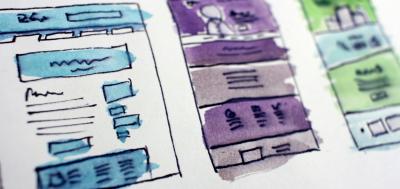To thoroughly investigate web design skills, paying close attention to the different facets of web design as both an art and a science is important. In doing so, it's evident that essential web designer skills generally depend on each web designer's specific areas of expertise of each web designer. Before we begin to separate web design into its various parts, however, it may be helpful to define the qualities that most web designers hold in common while detailing, "What does a web designer do?"
What Does a Web Designer Do?
In short, web designers design, create, and maintain websites. They want an immediate and lasting impact on the viewers' senses — yet website design goes far beyond pure sensory appeal. As they strategically place graphics, images, text, and audiovisual elements on each website page, web designers must pay close attention to purpose, performance, and aesthetics. These professionals ensure that websites are functional while providing visitors a smooth, seamless navigation experience.
Types of Web Design
The similarities and differences between aesthetics and functionality relate specifically to the similarities and differences between two distinct areas of web design: user experience (UX) design and user interface (UI) design.
UX Design
UX design concentrates on users' overall satisfaction as they view, hear, interact with, and generally experience a website. While the visual elements of pure graphic design play a central role in UX, so do purely practical elements such as navigability, ergonomics, and clickability. "UX design is how things work and how useful they are," writes Dionysia Lemonaki of the coding education organization FreeCodeCamp. "UX design focuses on the whole experience and the journey a user takes when using a product from start to finish."
Visual Design
UI, by contrast, is a subset of UX that concentrates on a website's desired resources and interactive elements of a website. This element of web design is highly visual in nature. "UI design is how things look," writes Lemonaki. "It focuses only on the visual aspects that a user interacts with and creates inclusive, accessible, pleasant, and aesthetically pleasing digital interfaces." For this reason, the term "UI design" is often used interchangeably with "visual design."
Overlap of Roles
Although UX and UI have different scopes and goals, they blend in many respects. Website design software company Figma identifies a concentration on final website use and an empathetic relationship with the website user as a common bond among UX and UI designers. Both disciplines require the diverse skills of multidisciplinary teams and rely upon similar sets of digital design tools.

What Skills Do You Need to Be a Web Designer?
From a solid understanding of essential coding languages such as HTML and CSS to soft skills such as effective time management and detail-oriented thinking, a quality web design professional should possess the following:
Understanding of the Principles of Visual Design
Whether working on a website or any other media form, designers must have a strong command of essential graphic design elements such as color, typography, proportion, contrast, balance, unity, and visual hierarchy.
Proficiency in Design Tools and Software
Web designers might turn to different digital design platforms depending on their particular wants and needs. However, familiarity with general design software like Adobe Creative Suite can benefit web designers of all kinds. From Adobe Photoshop to Illustrator to Premiere Pro, Adobe has countless tools for website design.
Knowledge of Responsive Design
People access websites on countless devices today. Responsive design ensures that a website will look equally good on a desktop, tablet, cell phone, and smart TV. This means designing web pages with flexible grids and images that fit screens of all shapes and sizes.
Essential Soft Web Design Skills

Though the "hard" or technical skills outlined above are critical to effective web design, you shouldn't underestimate the significance and impact of the following non-technical "soft" skills. Such web designer skills commonly separate outstanding designers from merely adequate designers.
Creativity – Website visitors who see something especially interesting, exciting, or unique on a website are far more likely to have a positive user experience. Many websites are exceptional works of art, and imaginative creativity places them on this lofty pedestal.
Analytical skills – In other roles, web designers must serve as problem-solvers. To overcome unforeseen challenges during the web design process, they must be able to analyze them systematically and accurately. Analytical skills are also helpful in understanding user behavior and improving user experience.
Communication – Strong communication skills are essential for web designers because they tend to work in multifaceted and multifunctional teams; strong communication skills are necessary for web designers. In many cases, they must also learn to communicate effectively with website design clients and other key project stakeholders.
Interdisciplinary collaboration – Beyond their communication capabilities, web designers should hone numerous soft skills to facilitate multidisciplinary collaboration better. Empathy, open-mindedness, and delegation skills rank at the top of this list.
How to Start a Career in Web Design
While a successful career in this field doesn't happen overnight, you can begin your efforts to become a web designer by securing a relevant college degree and building a compelling professional portfolio.
Getting a Degree in Web Design
It is generally challenging to land a solid job in web design without a college degree. For instance, the online bachelor's degree program in web design and development at Champlain College Online provides the well-rounded training needed to work professionally as a web designer.
Building a Web Design Portfolio
Most employers will ask to see a portfolio of your web design work before hiring you for a job. A portfolio lets them preview your work, evaluate your technical abilities, and understand your artistic style. To build an effective web design portfolio, focus on interactivity and ensure that you showcase only your very best work.
Web Design: Job and Career Outlook
Whether they seek news, shopping, or entertainment, modern people spend much of their lives online. So, it may come as little surprise that web design is a growth career. The United States Bureau of Labor Statistics (BLS) predicts that the job outlook for web designers will increase by 8% between 2023 and 2033. This is twice the average growth rate for all other occupations in the U.S.
Common Job Titles
What does a web designer do in more targeted, specific roles? As previously discussed, web design has many facets, and the average web design project involves multidisciplinary teams composed of specialized professionals. Furthermore, web designers' roles and job descriptions of web designers might vary considerably from company to company. Here are just a few standard job titles in the world of web design:
Web Designer – Generally covering all aspects of web design, a web designer is responsible for planning, creating, and testing a website's layout, interface, navigation, and functionality of a website.
Graphic/Visual Designer – A website's graphic or visual designer of a website is often the same as the web designer. However, a comprehensive and in-depth web design team might include a specialized graphic or visual designer who concentrates on purely visual elements of a website.
UX Designer – Simply put, UX designers focus on user experience principles that facilitate the delivery of relevant, meaningful, easy, and enjoyable experiences to users.
UI Designer – Conversely, a UI designer focuses exclusively on a website's visual and interactive components of a website.
Art Director – Working closely with UI designers and graphic or visual designers, web art directors guide a website's overall look and aesthetic of a website. They might also employ creative interactive elements.
Further Your Web Design Skills and Capabilities
Although building a solid portfolio is crucial, nothing can replace a relevant college degree as confirmation of your dedication and web designer skillset. An online Bachelor of Science in Web Design and Development from Champlain College Online (CCO) is a go-to option for busy people looking for a quality education. For more information about this degree program and other web design options at CCO, get in touch with our admissions department today.
Frequently Asked Questions
Web designers are responsible for planning, creating, and testing the layout, interface, navigation, and functionality of a website.
While they complement and overlap with each other in many ways, user experience (UX) and user interface (UI) design have different scopes and goals. UX design focuses on users’ overarching experience and satisfaction with a website. UI design involves the desired resources and interactive elements of a website with a specific emphasis on how it looks.
In addition to understanding the fundamental principles of visual design, web designers must work proficiently with digital design tools and have a strong knowledge of responsive design. They must also possess a variety of key soft skills including creative, communication, collaboration, and analytical skills.
Web design portfolios allow prospective employers or clients to preview your work, assess your technical proficiencies, and understand your artistic style before they consider hiring you for a web designer role.






